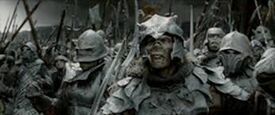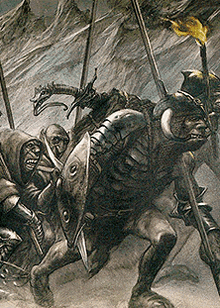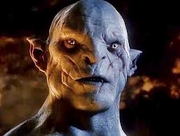- "Tolkien creates them to represent all that is bad about modern war."
- —Lynette Nusbacher in The Story of J.R.R. Tolkien: Master of the Rings
Orcs were the primary foot soldiers of the Dark Lords' armies and sometimes the weakest (but most numerous) of their servants. They were created by the first Dark Lord, Morgoth, before the First Age and served him and later his successor in their quest to dominate Middle-earth. Before Oromë first found the Elves at Cuiviénen, Melkor kidnapped some of them and cruelly tortured them, twisting them into the first Orcs.[1]
Many Orcs (along with fallen Maiar and other evil servants of Melkor) survived in the deep caves, pits, chambers, and tunnels of Melkor's great underground fortresses of Utumno and Angband. They multiplied and later spread through northern Middle-earth. They were first seen by the Dwarves who reported them to King Thingol, the High King of the Sindar, causing the latter to seek weapons of war for the first time.[2] For over a millennium, the orcs were only a minor problem, but when Melkor (Morgoth) returned with the Silmarils he took full charge of them and soon unleashed them on Beleriand. The newly organised orcs killed Denethor, the King of the lightly armed Laiquendi, but were eventually defeated by Thingol and his allies. They besieged the Havens of the Falas under Círdan, and the siege wasn't broken until the arrival of the Ñoldor. The heavy losses that the Sindar suffered at the hands of the Orcs frightened them to the point that Melian, Queen of Doriath raised a great enchantment to protect their kingdom. The Laiquendi, who suffered the most in the battle, hid themselves in the Ossiriand under the cloak of secrecy, or took refuge in Doriath.
History
Before the First Age
- "They were Elves once. Taken by the Dark Powers...tortured and mutilated...a ruined and terrible form of life..."
- — Saruman
Melkor was the first to learn of the Awakening of the Elves. He soon began sending evil spirits among the Elves, who planted seeds of doubt against the Valar. It is also rumoured that some of the elves were being captured by a "Rider" if they strayed too far, and the elves later believed these were brought to Utumno, where they were cruelly tortured and twisted into Orcs.
First Age
In the First Age, thousands of Orcs were bred in Angband by Morgoth and to participate in the Battles of Beleriand, which lasted 587 years. They first appeared in the Battle of Lhammoth, where they were defeated by the Noldor. When the House of Fëanor returned to Middle-earth Morgoth sent a force of Orcs against them. Although the Orcs outnumbered the exiles they were no match for the power and wrath of the Ñoldor, and were quickly and easily defeated. However, Fëanor could not defeat the power of Morgoth alone and he was killed, leaving the Orcs to continue to breed under the Dark Lord. Years later, when the House of Fingolfin arrived in Middle-earth, Orcs were sent against them as well, but they were utterly defeated in the Battle of the Lammoth.
After their crushing defeat in the Dagor Aglareb and in a minor raid on Hithlum, the Orcs nevertheless regained their numbers and fought again in large numbers in the Dagor Bragollach and Nirnaeth Arnoediad, where they and their master won crushing victories against the free peoples. They were nearly destroyed in the War of Wrath, and those that survived fled eastwards into the Mountains of Angmar and the Grey Mountains.
Second Age and on

Orcs of Mordor in Peter Jackson's The Lord of the Rings films
Sometime around SA 1000, Sauron reappeared in Middle-earth and made the land of Mordor his realm, and then started to build the foundations of Barad-Dûr. During the War of the Elves and Sauron in SA 1700, the Orcs formed the main host of Sauron's power. Despite the immeasurable number of Orcs present, the battle was won by the Elves and the Numenoreans due to their united force and numbers.
Until Sauron's final downfall in the Third Age, Orcs remained the backbone of the armies of Mordor, and of Isengard when Saruman ruled it.
Characteristics
- "For all that race were bred by Melko of the subterranean heats and slime. Their hearts were of granite and their bodies deformed; foul their faces which smiled not, but their laugh that of the clash of metal, and to nothing were they more fain than to aid in the basest of the purposes of Melko."
- —The Fall of Gondolin

Orcs of Mordor as depicted by John Howe
In J.R.R. Tolkien's writings, Orcs were cruel, wicked, hateful, black-hearted, and hated everybody and everything, particularly the orderly and prosperous.[3] Physically, they were short in stature (unless of the Uruk variety) and humanoid in shape. They were generally squat, broad, flat-nosed, sallow-skinned, bow-legged, with wide mouths and slant eyes, long arms, dark skin, and fangs. Tolkien describes one "huge Orc chieftain" as "almost Man-high", and some must have been close to Hobbit height, as Sam and Frodo were able to disguise themselves as Orcs in Mordor. They were roughly humanoid in shape with pointed ears, sharpened teeth and grimy skin. Their appearance was considered revolting by most of the other races. Orcs made no beautiful things, but many clever ones including machines, tools, weapons, and instruments of torture, were delighted by wheels, engines, and explosions, and could tunnel and mine as well as any but the most skilled Dwarves, though they are often untidy and dirty.[3] This was so since the time Melkor bred them (in an unknown process) from mutilated and corrupted Elves. They hated themselves, and had an even deeper hatred for Melkor, thus resulting as a violent and warlike race in a perpetual state of chaos with itself and others. Despite their abominable nature, Orcs were often crafty and clever rather than dim-witted. Tolkien writes that they were capable smiths and craftsmen, though their weapons and belongings are described as crude compared to those of the Free Peoples. Orcs also developed tunnel-making, so as to dwell underground away from the light.[citation needed]
Wickedness and violence were their nature, and it was not uncommon for them to kill each other in petty quarrels.[4] They had a destructive effect on nature, especially forests and, often destroyed trees to fuel their war-making, particularly those near Isengard. Orcs had unchangeable disdain for all Elves, Dwarves, and Men, though they fought alongside wicked men under Morgoth and then Sauron in the First and Third Age.
Etymology
In Tolkien's Sindarin language, "Orc" is orch, plural yrch. In his late, post-Lord of the Rings writings (published in The Peoples of Middle-earth), he preferred the spelling "Ork", evidently mainly to avoid the form Orcish, which would be naturally pronounced with the c as /s/ instead of /k/. (In Tolkien's languages the letter c was always pronounced /k/.) It is also possible that the word is a Common Tongue Version of 'orch', the Sindarin word for Orc. The original sense of the word seems to be "bogey", "bogeyman", that is, something that provokes fear, as seen in the Quenya cognate urko, pl. urqui. In the old English Orc means "demon."[5] The term Uruk-hai merely means "orc-folk" in the Black Speech, and was the Uruk-hai's name for themselves.
Other names
"Gorgûn" was the name that Ghân-buri-Ghân of the wild men of the Drúadan Forest used for the Orcs in their own language.
"Yrch" was the term used by Haldir and his brothers, who were Elves of Lothlórien. This same word was also used by Legolas, indicating that it is Sindarin.
Notable Orcs
Portrayal in adaptations
Peter Jackson's films
In Peter Jackson's two film trilogies, Orcs range greatly in appearance. Skin colour ranges from bone white (Azog and Bolg), to peachy colours (orcs like the lieutenant Gothmog in The Return of the King), to shades of green. Most Orcs however are shown as having darker shades of black or brown skin. Some are more human-like than others; Azog looks like a large and muscular but pale and hairless human, whilst Gothmog has a very deformed face. In general the Orcs tend to be shorter than most men. Some orcs shown are particularly slack with poor posture and broad with long arms, a shape represented best in Grishnákh's portrayal in The Two Towers; others, such as all Uruks, have a human posture. A new rendition of Orcs was introduced in The Hobbit: An Unexpected Journey: short mutated creatures covered in dubious warts and unidentified growths. They have pallid pinkish-white skin, large heads, and bat-like or porcine facial features.

Azog the Defiler in The Hobbit: An Unexpected Journey
The clothing and armour worn by Orcs in the films also ranges greatly. The orcs wear assortment of different styles of armour and clothing and also commonly have various piercings and tribal scars. Other Orcs wear specifically designed and made uniform armour for battle. They are often bald or are balding, while others have long, coarse hair. Their hair is most often dark or greying in colour, but in The Return of the King some Orcs with blonde hair and beards are seen marching from Minas Morgul.
Gallery
| File:295332 421581947923217 1235487333 n.jpg |
 |
 |
 |
 |
| File:The-hobbit-the-desolation-of-smaug-official-teaser-trailer-hd-mp4 0000706121.jpg |
 |
 |
Translations around the world
| Foreign Language | Translated name |
| Amharic | ዖርችስ |
| Arabic | الأورك |
| Armenian | Ործս |
| Basque | Orkora |
| Belarusian Cyrillic | Оркі |
| Bengali | ওর্চ্স |
| Bosnian | Orci |
| Bulgarian Cyrillic | Орките |
| Chinese | 兽人 |
| Croatian | Orci |
| Czech | Skřeti |
| Danish | Orker |
| Dutch | Orks |
| Esperanto | Orko |
| Finnish | Örkit |
| French | Orques |
| Galician | Orco |
| Georgian | ორკები |
| German | Orks |
| Greek | Ορκς |
| Gujarati | ઑર્ચ્સ |
| Hebrew | אורקים |
| Hindi | ॐर्च्स |
| Hungarian | Orkok |
| Icelandic | Orkar |
| Italian | Orchi |
| Japanese | オーク |
| Kannada | ಓರ್ಕ್ಸ್ |
| Kazakh Cyrillic | Орцс |
| Korean | 오크 |
| Kyrgyz Cyrillic | Орцс |
| Laotian | ອrຈຊ ? |
| Latvian | Orks |
| Lithuanian | Orkai |
| Macedonian Cyrillic | Орци |
| Marathi | ॐर्च्स |
| Mongolian Cyrillic | Орцс |
| Nepalese | ॐर्च्स |
| Norwegian | Orker |
| Pashto | ورچس |
| Persian | اورک |
| Polish | Orkowie |
| Romanian | Orcii |
| Russian | Орки |
| Sanskrit | ॐर्च्स् |
| Serbian | Оркови (Cyrillic) Orkovi (Latin) |
| Sinhalese | ඕර්ච්ස් |
| Slovak | Orkovia |
| Slovenian | Orki |
| Spanish | Orco |
| Swedish | Orcherna |
| Tajik Cyrillic | Орчс |
| Tamil | ஓகர்ஸ் |
| Telugu | ఓర్చ్స |
| Thai | ออร์ค |
| Turkish | Orklar |
| Ukrainian Cyrillic | Орки |
| Urdu | ورچس |
| Uzbek | Орчс (Cyrillic) Orchs (Latin) |
| Welsh | Orchod |
| Yiddish | ױרשס |
|
Races of Arda
Ainur | Dwarves | Elves | Ents | Great Eagles | Hobbits | Huorns | Men | Petty-dwarves | Skin-changers (Beornings) Servants of the Shadow:
Barrow-wights | Ettens | Dragons (Fire-drakes and Cold-drakes) | Ogres | Orcs | Spiders | Trolls | Úmaiar | Úvanimor | Vampires | Wargs | Werewolves |
References
- ↑ The Silmarillion: Quenta Silmarillion, "Of the Coming of the Elves and the Captivity of Melkor"
- ↑ The Silmarillion, Quenta Silmarillion, "Of the Sindar"
- ↑ 3.0 3.1 The Hobbit, Chapter IV: "Over Hill and Under Hill
- ↑ The Lord of the Rings, The Return of the King, Book Six, Ch. II: "The Land of Shadow"
- ↑ The Complete Guide to Middle-earth
